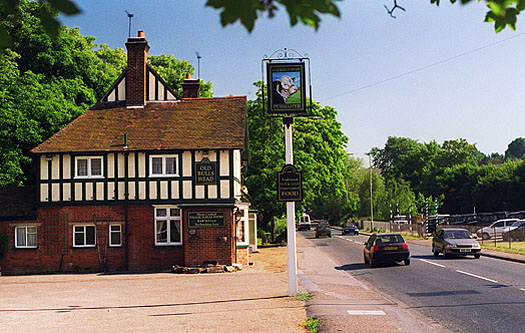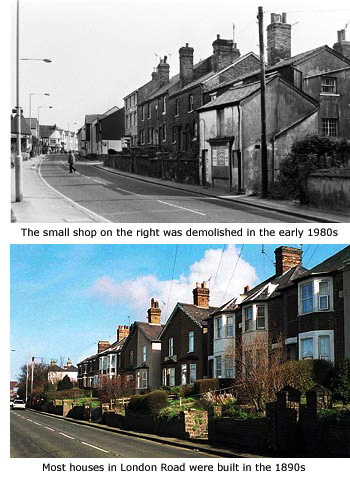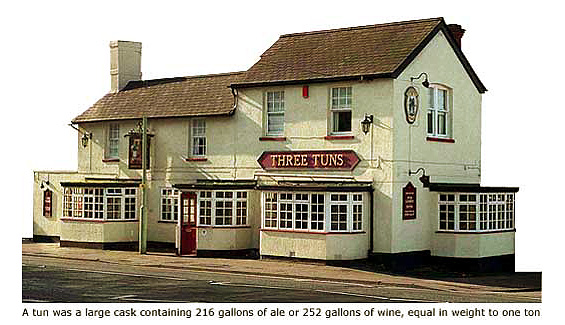|
|
|
 |
|
|
|
|
|
 |
|
|
|
 |
|
Guide map includes satellite image of this area
|
|
|
|
 |
|
A thin strip of pavement borders the outer wall of Thomas Heskin House (the former Railway Hotel), reducing the width of the B1183 here to its narrowist point along the entire stretch of road. There’s little room for traffic to manoeuvre and certainly no prospect of road widening without wholesale demolition.
Beyond this building, a low wall forms the boundary of British Telecom’s district depot – a large, contemporary style building of the 1960s that was the town’s telephone exchange until the 1980s. Alma Cottage had stood here previously – once a part of Sir Walter Gilbey’s estate.
 All Saint's Parish Hall stood where there is now the public car park, as did Hockerill Girls and Infants school, built in 1868. The parish hall also accommodated boys aged seven onwards from Hockerill Practising School (once part of the Teacher's Training College in Dunmow Road) and was known as Hockerill Boys school. When the Boys High School at London Road was built in 1957, boys transferred to there. The hall was also used to provide girls at Hockerill Practising School with school dinners and for social functions. Both schools were enlarged in 1880, then accommodating around 255 children, and both were demolished in the mid 1900s. All Saint's Parish Hall stood where there is now the public car park, as did Hockerill Girls and Infants school, built in 1868. The parish hall also accommodated boys aged seven onwards from Hockerill Practising School (once part of the Teacher's Training College in Dunmow Road) and was known as Hockerill Boys school. When the Boys High School at London Road was built in 1957, boys transferred to there. The hall was also used to provide girls at Hockerill Practising School with school dinners and for social functions. Both schools were enlarged in 1880, then accommodating around 255 children, and both were demolished in the mid 1900s.
Also here until the 1920s was the Crown malthouse and brewery, once an integeral part of the Crown Inn but later run as an independent business when the inn closed in 1872 (See Guide 9). All other maltings that survive in the town (and there are many) are now converted for either business or residential use – the one at the top of Harrington Close opposite the car park being no exception.
Overlooking the valley on the eastern side of London Road are late 19th century Victorian houses and cottages, their line broken midway by Grange Road which was built around the same period. Many local businessmen held properties here at the turn of the 20th century, among them George Speechley, Frederick Newey, and architect and local historian John Laybank Glasscock (1854–1929). He lived at No 50 Grange road from the early 1900s until his death in 1929. See Local History, below.
Also housed here in 1896 were the Sisters of St Mary of Namur, who arrived that year from Belgium to establish a Catholic school in Stortford. Which particular house the five sisters accommodated is unknown, but in it they conferred Baptisms until Windhill Lodge was acquired for use as a convent and school in 1898 (See Guide 4 – St Mary's School).
|
|
|
|
The property and land between Station Road and the station's eastern entrance was, until it became a victim of the recession of 2009, owned and occupied by a large National car sales business. Long before that, up until the early 1990s, the garage and workshops had been owned and run by long-standing Stortford resident, John Whalley (1914–2004), the business established on the same site by his father, also John, in the early 1900s.
At that time London Road was, for much of its length, only as wide as it is now adjacent to Thomas Heskin House. The wider road and pavement south of this point, adjacent to the former garage property, is due to the generosity of the late Mr Whalley, who in 1943 'gave' to the town council that part of his property abutting the original narrow highway. A grateful council, unable to carry out the road widening during the war years, completed the work in the late 1940s.
In the late 1800s the same site was used by the Patten brothers to sell carriages, carts and steam engines.
There were four Patten brothers; all of local origin, all farmers and all active on both sides of the Essex/Hertfordshire county border: Drury and William at Thorley Wash Farm, Henry at Woodside Green, and John at Little Hadham. It was John Patten who saw the potential for the newly invented steam ploughs and in 1919 formed a business selling them – the Leeds manufacturer regularly transporting ploughs to Bishop's Stortford station. The venture established the brothers’ reputation and they, along with the Pamplin Brothers, later became the main suppliers of agricultural machinery in this area.
|
|
|
|
|
|
Our knowledge of Bishop's Stortford's past comes from many sources; the earliest being manorial Court Rolls and St Michael's churchwardens' accounts. Court Rolls provide us with a unique insight into the working lives and relationships of the manor's inhabitants, while churchwardens' accounts are a bit like a local newspaper, recording not only church finances - from 1431 onwards - but also weaving into them the minutia of daily life. From 1539 onwards we have detailed records of virtually every birth, marriage and death within the parish, and from 1801 onwards we have the Census. Records kept by the legal profession add extra detail, as do those of town institutions and the town and district council. Last but not least we get the best possible insight into recent social history from the local newspaper archive, which in Stortford's case goes back to 1861.
Other sources are the works of early Hertfordshire historians, the most notable being John Weever (1576–1632), Sir Henry Chauncy (1632–1719), Nathanael Salmon (1675–1742), Robert Clutterbuck (1772–1831) and John Edwin Cussans (1837–1899). These were all learned individuals, but it has to be said their descriptive notes of the town's development through different periods could just as easily be termed as 'travel pieces'. Their works cannot be dismissed, but travelling and visiting so many of the county's towns and villages obviously didn't allow much time for any 'in-depth' research.
One person who did thoroughly research Bishop's Stortford's history, and is frequently referred to throughout this particular history, was John Laybank Glasscock junior (1854–1929): a man whose exceptional knowledge of the town's history from earliest times led to an archive of research notes that have since proved invaluable to every local historian that came after him. He also had an incredible antiquarian and archaeological knowledge and was, arguably, Hertfordshire's most consummate local historian.
John Laybank Glasscock (jnr) was born in Bishop's Stortford in 1854. He was the grandson of Thomas Glasscock who founded Glasscock’s building firm in 1827, and the son of John Laybank Glasscock senior (c1829–1895) who succeeded to the firm in 1847. J.L. Glasscock (Jnr) attended Bishop's Stortford College and in 1884 joined his father's firm which became J.L. Glasscock & Son. But by this time he had already made his mark as an historian. While still in his twenties he listed and mapped all of St Michael's monument inscriptions, then devoted the rest of his spare time translating early churchwardens' accounts. To this end he published Records of St Michael's Church, Bishop's Stortford in 1881.
When his father died in 1895 he took over the business, paying particular interest in the firm’s restoration of local old buildings. He carried out many important works in the town and district, including part restoration of the Boar's Head; removing every inch of plaster from the Black Lion's exterior to reveal the timber-frame construction we see today and, in the late 1890s, built the detached (and now unused) booking office on the London Road side of the railway station.
Glasscock also owned an old brickfield on the eastern side of Stansted Road, opposite Cannons Close, where in the early 1900s he found evidence of a Roman cremation cemetery. This find was the first indication of a Roman settlement in Stortford, confirmed in the 1950s when Cannons Close was developed.
In 1912, at the age of 58, he sold the building business to become architect to Benskins Brewery Watford, supervising property over a wide area, and involved himself in his many local interests. He was a member of the Horticultural Society, the Bowls Club, the Burial Board, several County Societies, the town Fire Brigade, a trustee of Bishop's Stortford Charities, and a Freemason for almost 40 years. In 1898 he instigated and co-founded (along with William Gerish) the East Herts Archaeological Society, and for many years lectured on ancient history in the town in connection with the old 'Student Association' and other local institutions.
Perhaps the pinnacle of his public service was becoming a member of Bishop's Stortford Urban District Council, eventually rising to Chairman. While holding this position he is credited with being solely responsible for securing Castle Gardens for the town when the land came up for sale in 1907.
In between all this he found time to marry, twice, producing three sons and a daughter. He died, aged 76, at midnight 18th March 1929 at his home, 50 Grange Road, and is buried at New Cemetery.
*J.L. Glasscock's publications, research notes and collections can be seen in Bishop's Stortford Museum and at the Hertfordshire Archive and Local Studies (HALS).
|
|
|
|
The Three Tuns
|
|
 |
|
|
|
 The original sign of the Three Tuns was the arms of the Brewers Company and the Vintners Company – liveries that once controlled many and various trades. This pub's earliest mention appears in the Manor of Stortford Rolls of 1710 recording payment of rent, but since that time it has undergone many structural changes, including the addition of several bay windows! The original sign of the Three Tuns was the arms of the Brewers Company and the Vintners Company – liveries that once controlled many and various trades. This pub's earliest mention appears in the Manor of Stortford Rolls of 1710 recording payment of rent, but since that time it has undergone many structural changes, including the addition of several bay windows!
A story handed down over the years relates to a former landlady by the name of Maggie – a lady so popular with locals the pub was often referred to as just Maggie’s. A better name, perhaps, might have been the 'Railway Tavern', because if ever a train was late in leaving the nearby station, it was alleged that the driver had probably popped into Maggie’s for a quick pint. In old age, Maggie had to go into hospital for a few days, but so as not to lose trade, customers were asked to get their own drinks and then tender payment into a 'courtesy' box. Needless to say, when Maggie returned, the accounts didn’t balance and it was some time before she paid off all the bills.
Two doors along from the Three Tuns is No 50 London Road, one of a terrace of 19th century houses that was once the Cross Keys public house. When it closed isn't quite clear but, apparently, the deeds of the house stipulate the property must never again be used as a pub.
|
|
[ BACK TO TOP ] |
|
|
|
|
|
|
|
|
|
|
|





 All Saint's Parish Hall stood where there is now the public car park, as did Hockerill Girls and Infants school, built in 1868. The parish hall also accommodated boys aged seven onwards from Hockerill Practising School (once part of the Teacher's Training College in Dunmow Road) and was known as Hockerill Boys school. When the Boys High School at London Road was built in 1957, boys transferred to there. The hall was also used to provide girls at Hockerill Practising School with school dinners and for social functions. Both schools were enlarged in 1880, then accommodating around 255 children, and both were demolished in the mid 1900s.
All Saint's Parish Hall stood where there is now the public car park, as did Hockerill Girls and Infants school, built in 1868. The parish hall also accommodated boys aged seven onwards from Hockerill Practising School (once part of the Teacher's Training College in Dunmow Road) and was known as Hockerill Boys school. When the Boys High School at London Road was built in 1957, boys transferred to there. The hall was also used to provide girls at Hockerill Practising School with school dinners and for social functions. Both schools were enlarged in 1880, then accommodating around 255 children, and both were demolished in the mid 1900s. The original sign of the Three Tuns was the arms of the Brewers Company and the Vintners Company – liveries that once controlled many and various trades. This pub's earliest mention appears in the Manor of Stortford Rolls of 1710 recording payment of rent, but since that time it has undergone many structural changes, including the addition of several bay windows!
The original sign of the Three Tuns was the arms of the Brewers Company and the Vintners Company – liveries that once controlled many and various trades. This pub's earliest mention appears in the Manor of Stortford Rolls of 1710 recording payment of rent, but since that time it has undergone many structural changes, including the addition of several bay windows!